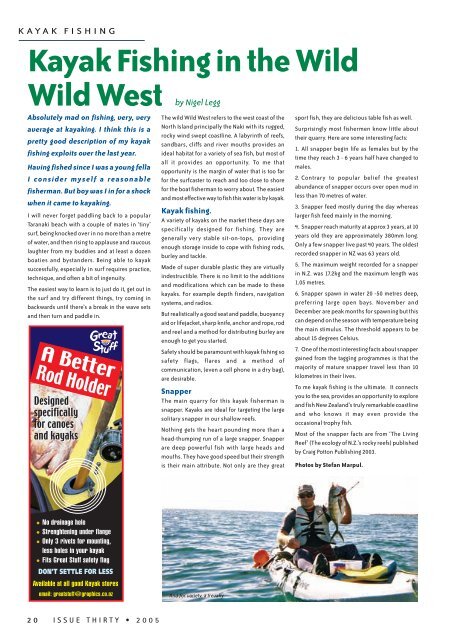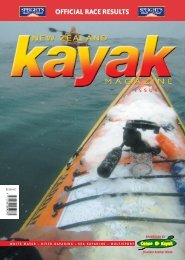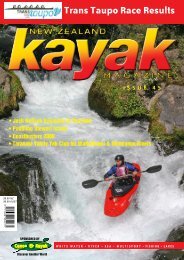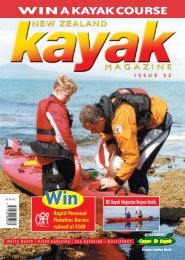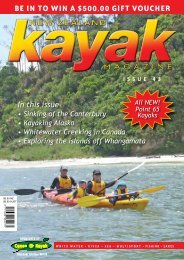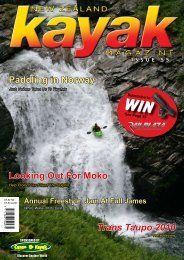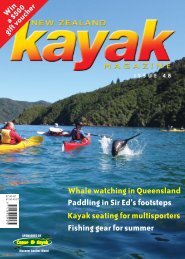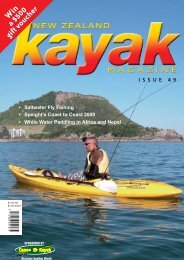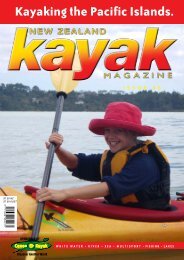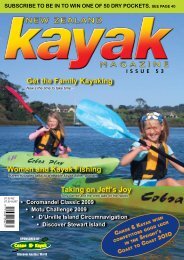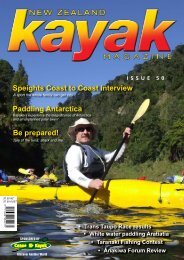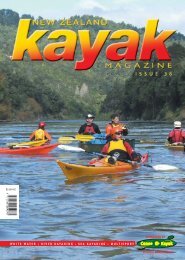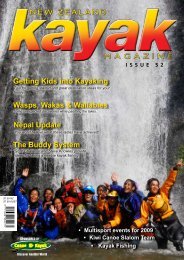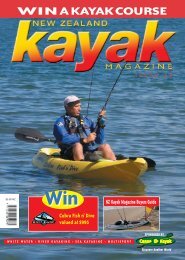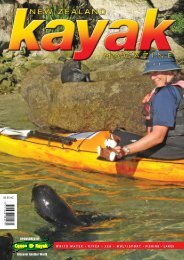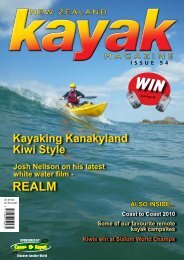C&K mag #30 sp - Canoe & Kayak
C&K mag #30 sp - Canoe & Kayak
C&K mag #30 sp - Canoe & Kayak
You also want an ePaper? Increase the reach of your titles
YUMPU automatically turns print PDFs into web optimized ePapers that Google loves.
KAYAK FISHING<br />
<strong>Kayak</strong> Fishing in the Wild<br />
Wild West by Nigel Legg<br />
Absolutely mad on fishing, very, very<br />
average at kayaking. I think this is a<br />
pretty good description of my kayak<br />
fishing exploits over the last year.<br />
Having fished since I was a young fella<br />
I consider myself a reasonable<br />
fisherman. But boy was I in for a shock<br />
when it came to kayaking.<br />
I will never forget paddling back to a popular<br />
Taranaki beach with a couple of mates in ‘tiny’<br />
surf, being knocked over in no more than a metre<br />
of water, and then rising to applause and raucous<br />
laughter from my buddies and at least a dozen<br />
boaties and bystanders. Being able to kayak<br />
successfully, e<strong>sp</strong>ecially in surf requires practice,<br />
technique, and often a bit of ingenuity.<br />
The easiest way to learn is to just do it, get out in<br />
the surf and try different things, try coming in<br />
backwards until there’s a break in the wave sets<br />
and then turn and paddle in.<br />
• No drainage hole<br />
• Strenghtening under flange<br />
• Only 3 rivets for mounting,<br />
less holes in your kayak<br />
• Fits Great Stuff safety flag<br />
DON’T SETTLE FOR LESS<br />
Available at all good <strong>Kayak</strong> stores<br />
email: greatstuff@graphics.co.nz<br />
20 ISSUE THIRTY • 2005<br />
The wild Wild West refers to the west coast of the<br />
North Island principally the Naki with its rugged,<br />
rocky wind swept coastline. A labyrinth of reefs,<br />
sandbars, cliffs and river mouths provides an<br />
ideal habitat for a variety of sea fish, but most of<br />
all it provides an opportunity. To me that<br />
opportunity is the margin of water that is too far<br />
for the surfcaster to reach and too close to shore<br />
for the boat fisherman to worry about. The easiest<br />
and most effective way to fish this water is by kayak.<br />
<strong>Kayak</strong> fishing.<br />
A variety of kayaks on the market these days are<br />
<strong>sp</strong>ecifically designed for fishing. They are<br />
generally very stable sit-on-tops, providing<br />
enough storage inside to cope with fishing rods,<br />
burley and tackle.<br />
Made of super durable plastic they are virtually<br />
indestructible. There is no limit to the additions<br />
and modifications which can be made to these<br />
kayaks. For example depth finders, navigation<br />
systems, and radios.<br />
But realistically a good seat and paddle, buoyancy<br />
aid or lifejacket, sharp knife, anchor and rope, rod<br />
and reel and a method for distributing burley are<br />
enough to get you started.<br />
Safety should be paramount with kayak fishing so<br />
safety flags, flares and a method of<br />
communication, (even a cell phone in a dry bag),<br />
are desirable.<br />
Snapper<br />
The main quarry for this kayak fisherman is<br />
snapper. <strong>Kayak</strong>s are ideal for targeting the large<br />
solitary snapper in our shallow reefs.<br />
Nothing gets the heart pounding more than a<br />
head-thumping run of a large snapper. Snapper<br />
are deep powerful fish with large heads and<br />
mouths. They have good <strong>sp</strong>eed but their strength<br />
is their main attribute. Not only are they great<br />
And for variety, a trevally.<br />
<strong>sp</strong>ort fish, they are delicious table fish as well.<br />
Surprisingly most fishermen know little about<br />
their quarry. Here are some interesting facts:<br />
1. All snapper begin life as females but by the<br />
time they reach 3 - 6 years half have changed to<br />
males.<br />
2. Contrary to popular belief the greatest<br />
abundance of snapper occurs over open mud in<br />
less than 70 metres of water.<br />
3. Snapper feed mostly during the day whereas<br />
larger fish feed mainly in the morning.<br />
4. Snapper reach maturity at approx 3 years, at 10<br />
years old they are approximately 380mm long.<br />
Only a few snapper live past 40 years. The oldest<br />
recorded snapper in NZ was 63 years old.<br />
5. The maximum weight recorded for a snapper<br />
in N.Z. was 17.2kg and the maximum length was<br />
1.05 metres.<br />
6. Snapper <strong>sp</strong>awn in water 20 -50 metres deep,<br />
preferring large open bays. November and<br />
December are peak months for <strong>sp</strong>awning but this<br />
can depend on the season with temperature being<br />
the main stimulus. The threshold appears to be<br />
about 15 degrees Celsius.<br />
7. One of the most interesting facts about snapper<br />
gained from the tagging programmes is that the<br />
majority of mature snapper travel less than 10<br />
kilometres in their lives.<br />
To me kayak fishing is the ultimate. It connects<br />
you to the sea, provides an opportunity to explore<br />
and fish New Zealand’s truly remarkable coastline<br />
and who knows it may even provide the<br />
occasional trophy fish.<br />
Most of the snapper facts are from ‘The Living<br />
Reef’ (The ecology of N.Z.’s rocky reefs) published<br />
by Craig Potton Publishing 2003.<br />
Photos by Stefan Marpul.


